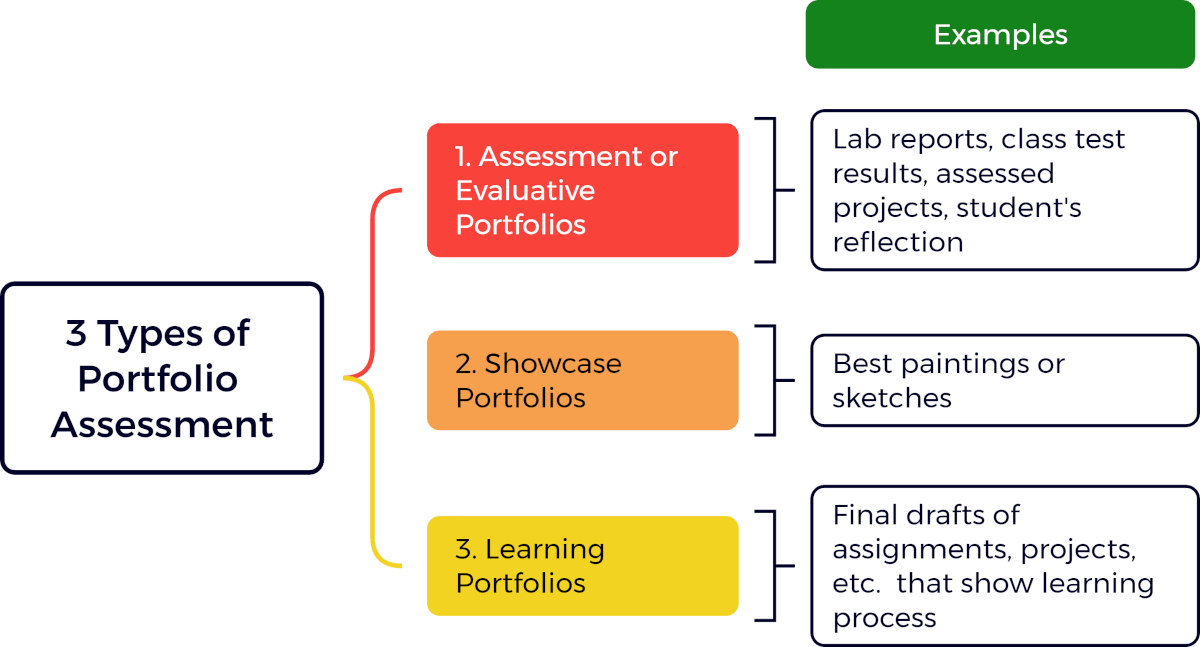What is portfolio assessment?
For non-education graduate students like me, bewilderment comes next whenever I see this word during training courses on curriculum development.
Two questions come to mind:
- How do I incorporate this form of assessment in the evaluation of student or even my performance as a professor or teacher?
- Does the application of this form of assessment enable teachers to evaluate their students or themselves better?
This article explains how it works and provides some examples with some useful links for further reading. Read on to find out and apply as part of your teaching strategy.
Table of Contents
Introduction
In the landscape of learning and professional development, the measure of student competency goes beyond isolated tests and examinations. Among the many assessment methods employed, portfolio assessment stands out for its holistic approach that links theory with practice.
This in-depth analysis aims to demystify portfolio assessment, exploring its definition, types, benefits, and real-life examples that shed light on its practical applications. While predominantly used in education, the insights derived from this approach are also transferable to professional development, demonstrating a broad spectrum of its functionality.
Defining Portfolio Assessment
Portfolio Assessment Defined
Portfolio assessment is a method of assessment often used in academic and professional fields, where an individual’s ability, progress, and achievement are evaluated through review of a pre-selected collection of work known as a portfolio. This portfolio may consist of various forms of work samples like projects, reports, examinations, observations, or other forms of evidence that reflect a person’s competency or growth over time.
Portfolio assessment can be very beneficial, as it provides a cumulative and comprehensive view of an individual’s achievements, rather than focusing on isolated performances or individual test scores. It supports interdisciplinary learning and promotes self-directed learning opportunities, helping individuals become independent, self-reflective learners.
Key Principles of Portfolio Assessment
Portfolio assessment follows 4 key principles (see Figure below).

The first one is the collection of evidence from various sources and across different periods, demonstrating the breadth and depth of an individual’s ability or progress.
The second essential principle is the organization and presentation of the collected works in a manner that enables easy and meaningful review.
The third principle involves evaluating the portfolio, usually by multiple reviewers, to ensure fairness and objectivity. Reviews may be based on established criteria or rubrics, or sometimes on relative progress and development.
The final principle is reflection, which is facilitated through the portfolio’s structure, encouraging the individual to reflect on their learning progress and areas of improvement.
Portfolio Assessment in Education
In an educational setting, portfolio assessment is often applied to demonstrate students’ learning and growth over the course of a school term or academic year.
Examples of elements included in an educational portfolio could be a series of writing assignments that demonstrate the progression of writing skills, art projects that reflect the development of artistic techniques, or science projects that show the understanding of scientific concepts.
Teachers may use portfolio assessment as a tool to gauge students’ understanding in a comprehensive manner, looking at the overall progress instead of individual marks from tests and quizzes. It also helps teachers identify areas where the student may need additional support or resources to improve.
In the age of AI, teachers need to recognize the potential of integrating AI tools into assessment protocols to enhance instructional efficiency and support more learner-centered environments (Khasawneh, et al., 2025). By automating routine tasks such as grading and initial feedback, AI enables educators to focus on cultivating critical thinking, creativity, and collaboration.
Tools like Grammarly, Quillbot, and Write & Improve assist with language accuracy and writing development, while platforms such as ChatGPT and ELSAspeak function as virtual tutors, offering real-time conversational practice and personalized feedback. Gamified learning platforms like Duolingo, Kahoot!, and Quizlet further engage students by turning practice into interactive and motivating experiences.
When thoughtfully embedded into the curriculum, these tools can complement traditional methods, fostering a more dynamic and responsive learning environment.
However, to ensure effective integration, teachers must receive adequate professional development, particularly on the ethical, pedagogical, and data privacy implications of AI use. Curriculum designers must also consider equity of access and algorithmic fairness, ensuring that AI technologies contribute meaningfully to both language acquisition and students’ emotional and cognitive development, rather than replacing the essential human elements of teaching.
Portfolio Assessment in Professional Development
In the field of professional development, portfolio assessments are used to evaluate and determine an individual’s professional competence and growth. For instance, in medicine, a practitioner might compile relevant case studies, patient feedback, peer reviews, training certificates, or research participation to form their professional portfolio.
This compilation provides a comprehensive and continuous record of a professional’s competence, demonstrating their ongoing learning, development, and progression in their field. The portfolio is frequently reviewed and updated to reflect the evolution and enhancement of a professional’s skills, abilities, and experiences over time.
The portfolio is frequently reviewed and updated to reflect the evolution and enhancement of a professional’s skills, abilities, and experiences over time.
Portfolio assessment serves as an all-encompassing approach to scrutinize individual development and learning. It champions a reflective, autonomous, and perpetual learning style.

Types of Portfolio Assessment
Why is Portfolio Assessment Distinctive?
Portfolio assessment stands out as an instructional, diversity-friendly evaluation method. It encapsulates a collection of a student’s work over an extended duration, demonstrating progress, competence, capacity, and accomplishment in specific fields.
Portfolio assessments are distinctive due to their ability to offer a comprehensive perspective of a student’s skills, showcasing not merely the knowledge they possess, but also how they utilize and convey this knowledge. The portfolio can encompass various elements such as written tasks, reading records, projects, self-evaluations, alongside reviews from classmates or instructors.
Three Types of Portfolio Assessment
There are various types of portfolio assessments, each with specific characteristics that suit its intended use. Portfolio assessments are categorized into three primary types: assessment portfolios, showcase portfolios, and learning portfolios.

1. Assessment Portfolios
Assessment portfolios, otherwise known as evaluative portfolios, contain work that has been evaluated according to set standards or criteria. These portfolios demonstrate a student’s ability to meet specific learning standards. They often contain rubrics, test results, student reflections, teacher’s notes, and graded assignments.
For instance, in a Science class, an assessment portfolio may contain lab reports, results from class tests, assessed projects, and the student’s reflection on their learning throughout the term. Evaluation is often comparative, and is accomplished by using scoring guides or rubrics. The main aim of an assessment portfolio is to display clear evidence of learning.
2. Showcase Portfolios
A showcase portfolio, on the other hand, represents the best work of a student. Unlike the assessment portfolio, the showcase portfolio allows the student to select their most outstanding work, hence demonstrating their highest level of learning and achievement. It can contain final drafts of assignments, projects, or any piece of work that the student is particularly proud of.
The purpose of a showcase portfolio is to provide a sense of accomplishment and to display one’s best abilities. An example might be a portfolio of an art student, presenting their best paintings or sketches.
3. Learning Portfolios
Lastly, learning portfolios, also known as process portfolios, document the learning process of a student. Unlike the other types of portfolios which emphasize on the final product, the learning portfolio focuses on the learning journey and the progress made. This may include drafts, revisions, mistakes, feedback, and reflections indicating how the student has overcome difficulties and improved over time.
For instance, in a literature class, a learning portfolio could include an initial draft of a book review, followed by the teacher’s comments, the revised drafts, and finally, the final version of the review. This allows for an accurate tracking of a student’s learning progression and the process of knowledge development over a period of time.
Comparison Between the Types
The primary difference between these three types of portfolios lies in their purpose and the type of work they encompass. Assessment portfolios are reliant on evaluated work to depict a student’s ability to align with specific learning standards. Showcase portfolios, however, are a collection of a student’s best work, exemplifying their skills, creativity, and personal learning outcomes. Learning portfolios focus on the student’s learning process, capturing their journey from inception to completion of learning objectives.
While each type has its individual strengths, they also have limitations. For example, assessment portfolios offer a comprehensive view of student achievements but may not fully capture a student’s creative abilities like a showcase portfolio would. Conversely, a showcase portfolio might not adequately demonstrate how the student has improved over a period. A learning portfolio can show this improvement, but it requires careful and continuous documentation and management to be effective.
Identifying the Ideal Portfolio
Deciding the right type of portfolio hinges upon the primary learning goals and the level of understanding needed about a student’s educational pursuits and accomplishments.
Benefits and Challenges of Portfolio Assessment
4 Benefits of Portfolio Assessment
Portfolio assessment technique is beneficial in a multitude of contexts, including educational and professional settings. I enumerate four of these in the next paragraphs and highlight the important benefits.
1. Allows for a Comprehensive Evaluation
Portfolio assessment allows for a comprehensive evaluation of one’s skills, knowledge, and performance, rather than focusing solely on a single task or test result. This holistic approach can more accurately reflect an individual’s learning or professional growth and provides deep insights which are often overlooked in traditional assessments.
2. Encourages Self-Assessment and Reflection
Portfolio assessment encourages self-assessment and reflection, promoting personal responsibility for one’s learning and development. Students or professionals actively engage in collecting, selecting, and analyzing their work, receiving feedback, and setting future goals. This process enhances their critical thinking and decision-making skills.
3. Offers Flexibility
Portfolio assessment is especially beneficial in settings where diverse skills and competencies need to be evaluated. It offers flexibility, as different kinds of evidence can be included depending on the specific skills or abilities one wants to showcase.
4. Provides a Tangible Record
Portfolio assessment provides a tangible record that can be utilized for future learning, professional growth, or performance evaluation purposes. Hence, you can always refer back to it whenever needed for some useful purposes such as program accreditation.
Challenges of Portfolio Assessment
Despite its numerous advantages, portfolio assessment also poses some challenges. A primary concern is that it requires substantial time and effort. Managing and maintaining a portfolio, particularly a physical one, can be time-consuming for both the evaluator and the individual being assessed. Considering the ongoing nature of portfolio assessment, this difficulty can become significant over time.
Another challenge pertains to the subjectivity of assessment. Given that portfolio includes a wide range of work, it can be difficult to standardize criteria and benchmarks for evaluation. Consequently, it may lead to inconsistences and bias during the review process.
Moreover, there could be issues with validity and reliability of the assessment. For example, in academic settings, unless closely monitored, students might submit work that was not solely theirs, casting doubt on the authenticity of the portfolio. In professional settings, embellishments or omissions of certain aspects of work might question the validity of the career narratives presented in the portfolios.
Addressing Potential Hurdles
In the face of potential challenges surrounding portfolio assessments, a host of strategic approaches can be adopted to ensure optimal benefits. Matters such as time and management can be effectively handled with digitally maintained portfolios that are simpler to organize.
Additionally, conducting training sessions for the evaluators guarantees that a consistent standard is maintained during the assessment process. To prevent biased evaluations, the institution of multiple independent reviewers can be beneficial.
Finally, to ensure the portfolio’s authenticity, individuals can be asked to orally defend their portfolios or provide written explanations detailing the learning process involved in each piece of their work.
When undertaken with meticulous planning and careful execution, portfolio assessments can act as a potent tool, enabling and monitoring growth and learning while providing invaluable insights for future pursuits.
Real-Life Portfolio Assessment Examples
Portfolio Assessment in Education
A classic example of the use of portfolio assessment is in the field of education.
For instance, a student portfolio may contain essays, projects, examinations, and other types of work carried out over the semester or academic year. Such a portfolio would demonstrate a student’s growth and achievement, as well as their critical thinking skills, creativity, and level of effort.
Through these assessment portfolios, teachers can evaluate student’s learning progress compared to the curriculum standards and objectives. Notably, teachers also provide feedback and offer minibreaks to guide students in the learning process.
Portfolio Assessment in Clinical Training
In the medical field, portfolio assessment is widely used in clinical training. Medical students are often required to maintain a portfolio of the procedures they carried out, observations made, case reports, reflective pieces, and supervisor’s feedback throughout their clinical training. This allows the instructors to assess their competency, readiness and performance progress in the clinical environment. Portfolio assessment gives a more comprehensive analysis of clinical competency compared to traditional assessments, such as multiple-choice tests.
Portfolio Assessment in Job Application Process
In the professional arena, portfolio assessment is commonly used in the job application process. A job applicant’s portfolio could include a resume, samples of work, letters of recommendation, certifications, and diplomas. An applicant may also add reflective narratives to explain the context of their work and what they were able to learn or achieve. This provides the hiring managers a comprehensive view of the applicant’s skills, achievements, and experiences, enhancing the likelihood of fair candidate assessment.
Portfolio Assessment in Art and Design
In the field of Art and design, portfolio assessments are absolutely critical. An artist or design professional’s portfolio can include sketches, paintings, designs, photographs, and other creative works. The works in the portfolio stand as a testimony to their creative and technical skills, their unique style, and their visual communication capabilities.
Portfolio Assessment in Real Estate
In the context of real estate, a portfolio assessment might involve the extensive analysis of a set of property investments. An investor might compile a portfolio containing details about property values, rental income, property conditions, locations, market trends, amongst other aspects. The assessment of this portfolio helps to determine the feasibility, profitability, and risks associated with each property, enabling wise investment decisions.
Overall Conclusion
Overall, portfolio assessment stands as a versatile method that gives a holistic picture of an individual’s abilities, growth, and achievements over a certain period. Whether it’s in a learning environment, during a job application, or within different professional fields, portfolio assessments can serve several purposes and offer insightful results.
Employing portfolio assessment in various fields stands as a testament to its adaptability and efficacy. It is not without its challenges, of course, but the array of advantages it offers is undeniably valuable.
Portfolio assessment amplifies the learning experience, fostering deeper understanding and encouraging self-directed learning. Explicit real-life examples gathered across multiple disciplines delineate the versatility of its application, illuminating its potential as a key tool in learning and professional development.
A thorough comprehension of portfolio assessment bolsters the journey of continuous learning and growth, paving the way for a more comprehensive and engaging educational journey.
At this point, portfolio assessment is no longer alien to you. On my part, I realized that this performance assessment presents a whole new world of possibilities in my teaching profession. It’s not too late to use portfolio assessment as an alternative to common assessment tools that we used to apply in imparting knowledge and learning to the students, and even in evaluating ourselves as we ponder how far we have gone in our professional development journey.
Reference
Khasawneh, M. A. S., Aladini, A., Assi, S. A., & Ajanil, B. (2025). Portfolio assessment in AI-enhanced learning environments: a pathway to emotion regulation, mindfulness, and language learning attitudes. Language Testing in Asia, 15(1), 5.
Updated: 7 August 2025


